
Kosciuszko site honors war hero
PHILADELPHIA — In August, 1776, one month after the Continental Congress signed the Declaration of Independence; Gen. Thaddeus Kosciuszko arrived in Philadelphia determined to become one of the first foreign fighters of the American Revolution.
Enthralled by the principles of liberty and human dignity drafted in the declaration, Kosciuszko volunteered into the Continental Army; and, two months later Congress commissioned him a Colonel of Engineers and he began fortification of the capital city.
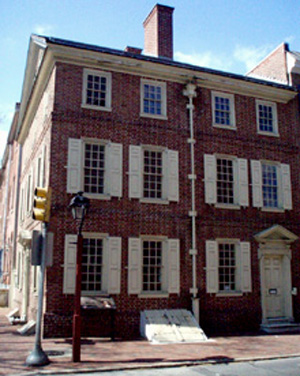 |
Located on the corner where 3rd and Pine streets intersect, the Thaddeus Kosciuszko National Memorial depicts the life and values of the Polish patriot and American revolutionary hero (Photo by Michael Holt). |
“Kosciuszko adds real depth to American revolutionary history, proving that the fight for independence was an international affair that affected more people than just those in the 13 colonies and Great Britain,” said Jane Cowley, a public affairs officer with Independence National Historic Park (INHP).
After his military service in America, Kosciuszko championed human rights and liberty on a second continent, as he led a failed insurrection in his native Poland against Czarist Russian rule. Although he had been captured and severely wounded in the uprising.
Following a term of imprisonment he was exiled from his homeland. Thereafter, the polish patriot returned a second time to Philadelphia in August, 1797. Here, 10 years after the U.S. Constitution was ratified, cheering crowds and booming cannon salutes greeted Philadelphia’s foreign born son of liberty to a hero’s welcome.
| The Thaddeus Kosciuszko National Memorial in Philadelphia (Photo by Michael Holt). | 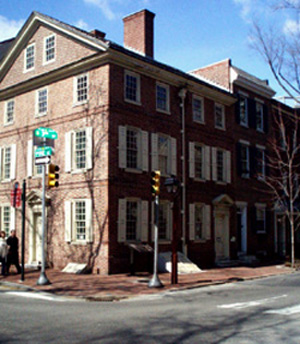 |
“I beg you to be assured that no one has higher respect and veneration for your character than I have,” Gen. George Washington later wrote to Kosciuszko upon his arrival. “No one more seriously wished, during your arduous struggle in the cause of liberty and your country, that it might be crowned with success.”
Kosciuszko, primarily, had come to seek medical care and to petition Congress for back pay regarding his outstanding military service. In the end, he would receive compensation in the form of 500 acres of land in Ohio and $19,000 for his services, along with American citizenship.
While living in Philadelphia he resided in a small second floor room in Ann Relf’s boarding house through the months of November 1797 to May 1798. Located at 301 Pine Street, here the three-story brick house now commemorates the values Kosciuszko espoused during his life. First listed on the National Register of Historic Places on Dec. 18, 1970, the home where he often entertained guests, because he found it too difficult to move uninhibited from his wounds, was officially recognized on Oct. 21, 1972.
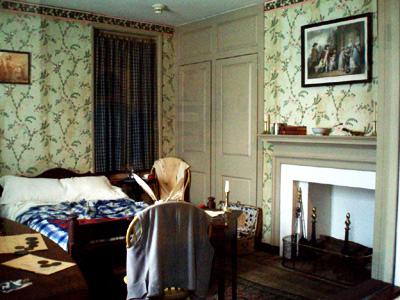 |
This second floor room where Kosciuszko resided from November 1797 to May 1798 has been recreated to appear as it would have looked when he stayed here (Photo by Michael Holt). |
“At 0.02 acre (80 square meters), the Thaddeus Kosciuszko National Memorial is often referred to as America’s smallest national park. As the memorial is counted as a separate independent unit of the national park system,” Cowley said. “Nevertheless, it is administered under Independence National Historical Park.”
Kosciuszko truly embraced the principles of liberty and human equality adopted in the declaration; in fact, he felt so inspired by the rhetoric set forth in the text that he decided to meet with Thomas Jefferson, the principal author of the document. After a while, the two men would meet in Virginia, where they espoused similar philosophies on politics and life. In the end, the two would become very close friends.
“[Kosciuszko] is the purest son of liberty among you all that I have ever known, the kind of liberty that extends to all, not only to the rich,” Thomas Jefferson wrote to Horatio Gates in February 1798.
A life-long crusader of the cause of liberty he also sought to purchase the freedom and education of enslaved Africans in the U.S bequeathed through his will. Not surprisingly, Kosciuszko asked his good friend, and then Vice President, Thomas Jefferson to be the executor of his will. However, subsequent to a lengthy legal battle that ended up in the U.S. Supreme Court, Kosciuszko’s estate went to his relatives.
| This bronzed cast, on display at the Thaddeus Kosciuszko National Memorial, depicts an older Kosciuszko as he would have appeared later in adulthood (Photo by Michael Holt). | 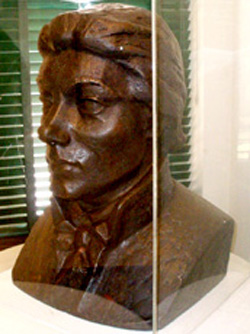 |
As a national hero of two continents Kosciuszko became the namesake of numerous places in the world. Interestingly, the Polish explorer Count Paweł Edmund Strzelecki named the highest mountain in Australia, Mount Kosciuszko, for him. Nowadays the mountain is the central point of the Kosciuszko National Park in Australia.
Furthermore, he is also the namesake for numerous statutes, bridges, streets and parks across the United States and the world. Not to mention in Poland where every major town has a street or a square named after Kosciuszko.
Kosciuszko’s Military and Engineering Expertise
“Representative of the many foreign patriots who helped the U.S. win its war for independence, Kosciuszko used his military engineering expertise and problem solving ability to aid the Continental Army tremendously,” Cowley said.
His first task in America was the fortification of Philadelphia. His first structure was Fort Billingsport. More important to the security of the capital, in September, 1776, Kosciuszko fortified the banks of the Delaware River against British naval assault.
One of his greatest military accomplishments came when he was attached to the Northern Army under Gen. Horatio Gates. As chief engineer of the army, his construction of several fortifications along the Canadian border allowed for a successful retreat from Ticonderoga. Subsequently, his selection and fortification of Bemis Heights overlooking the Hudson River resulted in the Americans first major victory at Saratoga, where 6,000 British troops surrendered. Many historians believe this to be the turning point of the revolutionary war.
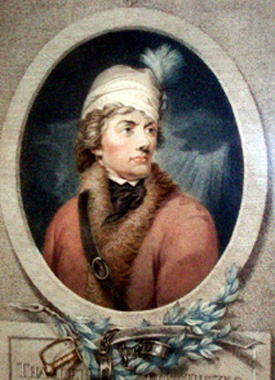 |
During the Polish insurrection of 1794, thousands of peasants, many armed with only their scythes, fought to preserve their homeland. Known as the “Leader of the Scythe-bearers” Kosciuszko adopted their cap and tunic as his uniform (Photo by Michael Holt). |
After these successes, Kosciuszko was regarded as one of the best military engineers in American service. His next assignment, and perhaps his most prestigious, came in March 1778, when Gen. George Washington put him in charge of military engineering works at West Point along the Hudson River. For 28 months, he planned and built permanent fortifications at West Point, and was so successful that the British never attacked. After seven years of service, on Oct. 13, 1783, Kosciuszko was promoted by Congress to the rank of brigadier general.
Renovations Planned
The Harpers’ Ferry Center and Interpretation and Visitor Services staff are finalizing plans for the installation of new permanent exhibits at the Thaddeus Kosciuszko National Memorial in November 2008. These renovations are possible since the memorial successfully competed for $281,000 in project funding through the National Park Service fee demo program in 2004.
“We will be installing 90% of the exhibits, which will be static, meaning they will remain here, and we will have one museum case that we will be revolving around a single piece, which will be on loan from the different museums of Poland” said Mary Jenkins, an Interpretive Program Specialist with INHP.
The new exhibits will include some interactive elements to engage younger visitors, including a video that highlights the many monuments dedicated to Kosciuszko, along with dozens of towns, streets, bridges, parks and mountains named after him. Another special feature of the new installations will be a custom-designed case to exhibit original Kosciuszko artifacts from the six major museums in Poland. The memorial hopes to feature each one of the Polish museum Kosciuszko artifact collections annually for the next six years.
Additionally, the new exhibits will support a theme that emphasizes Kosciuszko as a life long champion of freedom and human rights.
| This portrait depicts a more youthful Kosciuszko (Photo by Michael Holt). |
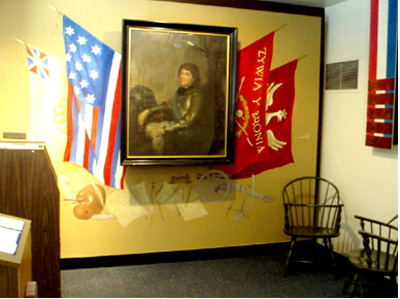 |
“When you walk in off of Pine Street, the first room will emphasize Kosciuszko’s important contributions as a brilliant military engineer in the American Revolution. Then, the next room over will be dedicated to the insurrection he lead in Poland and will include more collections that display his valiant efforts to free Poland from Russian rule. Also, in that room we will include facts learned about his childhood in Poland,” Jenkins said. “Finally upstairs will remain the same, restored to how it would have looked in 1798 based on the writings of Thomas Jefferson.”
If You Go
- Location: Thaddeus Kosciuszko National Memorial, 301 Pine St., Philadelphia, Pa. 19106.
- Hours of Operation: Open Wednesday to Sunday 12 p.m. to 4 p.m., closed Mondays and Tuesdays. closed Veterans’ Day, Thanksgiving, Christmas and New Years’ Day.
- Entrance Fee: None.
- Directions: Car Eastbound, via I-76 (the Schuylkill Expressway) – Exit onto I-676 East (toward “Central Philadelphia) and follow it to the 6th Street exit. At the bottom of the exit ramp follow signs for Independence Park Visitor Center. Westbound by car: After crossing the Ben Franklin Bridge – stay in the right hand lane and follow signs for Independence Visitor Center. Northbound by car: via I-95 – Exit at “Independence Hall/Historic Area”. At bottom of ramp follow signs for Independence Visitor Center. Southbound by car, via I-95 – Use “Independence Hall/Historic Area” exit. At the bottom of the exit ramp follow signs for Independence Visitor Center.
- Public Transportation If you arrive in the city by train or bus, take the Market- Frankford subway east to 5th and Market Streets. Walk two blocks east to 3rd Street. Travel south and proceed 5 blocks to the Kosciuszko House.
- Parking: Parking is available on the both sides of the street.
- Independence National Historic Park Visitor Information: Phone: 215-597-9618
Fax: 215-861-4950, mailing address: 143 S. Third Street, Philadelphia, PA 19106; http://www.nps.gov/thko/ - Facilities: The house is not handicap accessible yet. A ramp will be installed in the near future.

Comments are Closed